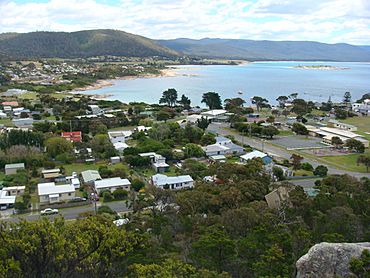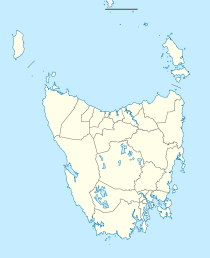Bicheno, Tasmania facts for kids
Quick facts for kids BichenoTasmania |
|||||||||
|---|---|---|---|---|---|---|---|---|---|
 |
|||||||||
| Population | 943 (2016 census) | ||||||||
| • Density | 5.6/km2 (15/sq mi) | ||||||||
| Postcode(s) | 7215 | ||||||||
| Area | 151.1 km2 (58.3 sq mi) | ||||||||
| Location |
|
||||||||
| LGA(s) | Glamorgan Spring Bay Council | ||||||||
| State electorate(s) | Lyons | ||||||||
| Federal Division(s) | Lyons | ||||||||
|
|||||||||
Bicheno is a lovely town on the east coast of Tasmania, Australia. It's about 185 kilometers (115 miles) north-east of Hobart along the Tasman Highway. Around 950 people live here. Bicheno is known as a busy fishing port and a fun beach resort. It's part of the Glamorgan-Spring Bay area.
Contents
History of Bicheno
Bicheno got its name from James Ebenezer Bicheno. He was a British Colonial Secretary for Van Diemen's Land (which is what Tasmania was called back then). The name Bicheno was first used in 1851.
The first time this area was written about was by James Kelly. He was exploring around Van Diemen's Land. He stopped here, when it was called Waubs Harbour, to dry his supplies.
In the late 1830s and early 1840s, Waub's Harbour was a place where people hunted whales from the shore. They would catch whales close to the coast.
Bicheno officially became a township in 1866. The Bicheno Post Office first opened its doors on January 1, 1855.
What to See and Do in Bicheno
Bicheno has many interesting features and activities for visitors.
Wauba Debar's Story
In Lions Park, you can find the grave of Wauba Debar. Waub's Harbour was named after her. She was an Aboriginal woman who was taken from her tribe when she was young. She became known for her bravery. She once saved two sealers during a big storm. A special headstone remembers her courage.
From Farming to Fishing
In the mid-1840s, the land around Bicheno was used for farming. This still happens today. Coal was found here in 1848. In 1854, the harbour was made bigger. This was to help transport coal from nearby mines. The coal was moved to the port using a 5-kilometer (3-mile) tramway pulled by horses. You can still see coal in this area today.
Bicheno was not a coal port for very long. When gold was discovered in Victoria in 1855, many people left Bicheno to find gold. For almost 100 years, Bicheno was a quiet fishing village. Fishing is still very important to the town. People catch lots of crayfish, abalone, scallops, and trevally. Many tourists love to eat fresh fish and chips by the water.
Bicheno Today
Today, Bicheno is a very popular place for tourists. There are many places to stay, craft shops, and cafes. Visitors also love to see the little penguin colony on nearby Diamond Island. It's important to be respectful of these wild animals. You can even take a guided tour to a special protected area where the penguins live.
The area is great for picnics. There are also many vineyards around Bicheno. You can taste local wines at The Farm Shed. A cool natural spot to visit is the Bicheno Blowhole.
Some famous people have lived in Bicheno. These include the world champion swimmer Shane Gould. There are also famous artists like painter Vanessa Richardson, surf photographer Mathew Tildesley, and jeweller Carl Noonan. A group of people even meet every morning to swim in the cold water at Waubs Bay, no matter the weather!
In September 2003, a special memorial was built in Bicheno. It honors the merchant navy. The merchant navy is made up of ships that carry goods and people around the world. Five months later, in February 2004, Bicheno gave a special honor to the Australian Merchant Navy. It was the first time any town in the world had given this kind of "freedom of the city" honor to the merchant navy. Children from the local primary school help take care of this memorial, which is near Wauba Debar's grave.
Bicheno is part of the Glamorgan Spring Bay council area.
Population of Bicheno
In the 2016 Census, there were 943 people living in Bicheno. Most people, about 76.6%, were born in Australia. Also, 86.0% of people spoke only English at home. When asked about religion, 37.7% said they had no religion, and 23.7% were Anglican.
Climate in Bicheno
Bicheno has a mild oceanic climate. This means it has mild summers and mild winters. The highest temperature ever recorded was 38.9 °C (102.0 °F) on January 31, 1968. The lowest temperature ever recorded was −0.6 °C (30.9 °F) on July 15, 1966.
| Climate data for Bicheno (Council Depot) (11 m AMSL) | |||||||||||||
|---|---|---|---|---|---|---|---|---|---|---|---|---|---|
| Month | Jan | Feb | Mar | Apr | May | Jun | Jul | Aug | Sep | Oct | Nov | Dec | Year |
| Record high °C (°F) | 38.9 (102.0) |
37.8 (100.0) |
35.4 (95.7) |
30.6 (87.1) |
26.7 (80.1) |
21.1 (70.0) |
19.4 (66.9) |
23.2 (73.8) |
30.6 (87.1) |
31.4 (88.5) |
35.1 (95.2) |
36.9 (98.4) |
38.9 (102.0) |
| Mean daily maximum °C (°F) | 21.6 (70.9) |
21.5 (70.7) |
20.6 (69.1) |
18.9 (66.0) |
16.6 (61.9) |
14.6 (58.3) |
14.1 (57.4) |
14.7 (58.5) |
16.2 (61.2) |
17.5 (63.5) |
18.5 (65.3) |
20.1 (68.2) |
17.9 (64.2) |
| Mean daily minimum °C (°F) | 13.1 (55.6) |
13.2 (55.8) |
12.2 (54.0) |
10.2 (50.4) |
8.5 (47.3) |
6.7 (44.1) |
6.1 (43.0) |
6.4 (43.5) |
7.4 (45.3) |
8.6 (47.5) |
10.3 (50.5) |
11.7 (53.1) |
9.5 (49.1) |
| Record low °C (°F) | 5.0 (41.0) |
6.5 (43.7) |
3.0 (37.4) |
2.0 (35.6) |
0.9 (33.6) |
−0.5 (31.1) |
−0.6 (30.9) |
0.7 (33.3) |
0.4 (32.7) |
0.7 (33.3) |
1.2 (34.2) |
2.2 (36.0) |
−0.6 (30.9) |
| Average rainfall mm (inches) | 54.0 (2.13) |
57.4 (2.26) |
57.2 (2.25) |
56.8 (2.24) |
55.4 (2.18) |
62.0 (2.44) |
50.9 (2.00) |
51.1 (2.01) |
43.8 (1.72) |
54.7 (2.15) |
61.8 (2.43) |
67.9 (2.67) |
679.6 (26.76) |
| Average rainy days (≥ 0.2 mm) | 8.2 | 8.3 | 8.3 | 9.0 | 9.1 | 9.6 | 9.3 | 9.9 | 9.0 | 10.3 | 10.5 | 10.0 | 111.5 |
| Source: Bureau of Meteorology | |||||||||||||
Images for kids
-
Red lichen makes these rocks look red, just north of Bicheno. You can see the town in the distance.
See also
 In Spanish: Bicheno para niños
In Spanish: Bicheno para niños





